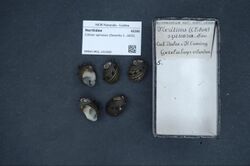Biology:Clithon spinosum
| Clithon spinosum | |
|---|---|

| |
| Clithon spinosum shells | |
| Scientific classification | |
| Kingdom: | |
| Phylum: | |
| Class: | |
| (unranked): | |
| Superfamily: | |
| Family: | |
| Subfamily: | Neritinae
|
| Tribe: | Theodoxini
|
| Genus: | |
| Species: | C. spinosum
|
| Binomial name | |
| Clithon spinosum (G. B. Sowerby I, 1825)
| |
| Synonyms[2] | |
|
Neritina spinosa G. B. Sowerby I, 1825 (original combination) | |
Clithon spinosum is a species of brackish water and freshwater snail with an operculum, a nerite. It is an aquatic gastropod mollusk in the family Neritidae, the nerites.
Distribution
Distribution of Clithon spinosum include Indo-Pacific and it ranges from New Guinea[3] and south-eastern Asia and eastern Asia to Marquesas.[4] It also occurs in Japan,[5] New Georgia,[6] Fiji[3] and Tahiti[3] and in French Polynesia including the following Society Islands: Tahiti, Mo'orea, Raiatea, Huahine.[4]
Description
There are always spines on its shell.[3] Spines are long and thin and they are directed rearward.[7] The width of the shell is 15–20 mm.[8]
Ecology
Clithon spinosum is a dioecious (it has two separate sexes) and amphidromous snail.[4] Adults live in freshwater and larvae are marine.[4] Larvae are long-lived planktotrophs.[4] Adults prefer boulders and cobbles over granules as a substrate.[7][5] They were found mainly on bottom of rocks in aquaria and in situ.[7] They are reported from altitude 0–10 m a.s.l.[7] They can reach densities up to 57.0 ± 17.3 snails per square meter of a stream.[7] Adults can survive 8 hours in seawater (longer exposure was not tested).[7]
It is not used as food source by humans.[4]
References
- ↑ The IUCN Red List of Threatened Species. Version 2016-2. <www.iucnredlist.org>. Downloaded on 06 September 2016.
- ↑ Bouchet, P.; Rosenberg, G. (2016). Clithon spinosum (G. B. Sowerby I, 1825). In: MolluscaBase (2015). Accessed through: World Register of Marine Species at http://www.marinespecies.org/aphia.php?p=taxdetails&id=737522 on 2016-09-06
- ↑ 3.0 3.1 3.2 3.3 Haynes A. (1988). "Notes on the stream neritids (Gastropoda: Prosobranchia) of Oceania". Micronesica 21: 93–102. PDF.
- ↑ 4.0 4.1 4.2 4.3 4.4 4.5 Myers M. J., Meyer C. P. & Resh V. H. (2000). "Neritid and thiarid gastropods from French Polynesian streams: how reproduction (sexual, parthenogenetic) and dispersal (active, passive) affect population structure". Freshwater Biology 44(3): 535–545. doi:10.1046/j.1365-2427.2000.00599.x.
- ↑ 5.0 5.1 Blanco J. F. & Scatena F. N. (2007). "The spatial arrangement of Neritina virginea (Gastropoda: Neritidae) during upstream migration in a split‐channel reach". River Research and Applications 23(3): 235–245. PDF.
- ↑ Haynes A. (1990). "The numbers of freshwater gastropods on Pacific islands and the theory of island biogeography". Malacologia 31: 237-248.
- ↑ 7.0 7.1 7.2 7.3 7.4 7.5 Liu H. T. T. & Resh V. H. (1997). "Abundance and microdistribution of freshwater gastropods in three streams of Moorea, French Polynesia". International Journal of Limnology 33(4): 235–244. doi:10.1051/limn/1997022.
- ↑ Tryon G. W. (1888–1889) Manual of Conchology, structural and systematic, with illustrations of the species. Volume 10, 322 pp., 69 plates. page 63, plate 23, figure 6–7.
External links
Wikidata ☰ Q28431717 entry
 |

